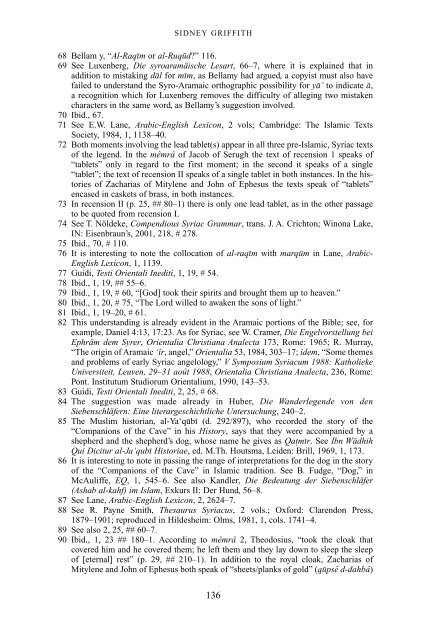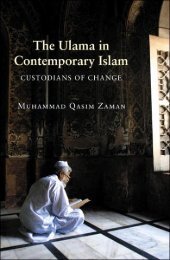The Qur'an in its historical context (pdf - Islam and Christian-Muslim ...
The Qur'an in its historical context (pdf - Islam and Christian-Muslim ...
The Qur'an in its historical context (pdf - Islam and Christian-Muslim ...
You also want an ePaper? Increase the reach of your titles
YUMPU automatically turns print PDFs into web optimized ePapers that Google loves.
SIDNEY GRIFFITH<br />
68 Bellam y, “Al-Raqim or al-Ruqud?” 116.<br />
69 See Luxenberg, Die syroaramäische Lesart, 66–7, where it is expla<strong>in</strong>ed that <strong>in</strong><br />
addition to mistak<strong>in</strong>g dal for mim, as Bellamy had argued, a copyist must also have<br />
failed to underst<strong>and</strong> the Syro-Aramaic orthographic possibility for ya’ to <strong>in</strong>dicate a,<br />
a recognition which for Luxenberg removes the difficulty of alleg<strong>in</strong>g two mistaken<br />
characters <strong>in</strong> the same word, as Bellamy’s suggestion <strong>in</strong>volved.<br />
70 Ibid., 67.<br />
71 See E.W. Lane, Arabic-English Lexicon, 2 vols; Cambridge: <strong>The</strong> <strong>Islam</strong>ic Texts<br />
Society, 1984, 1, 1138–40.<br />
72 Both moments <strong>in</strong>volv<strong>in</strong>g the lead tablet(s) appear <strong>in</strong> all three pre-<strong>Islam</strong>ic, Syriac texts<br />
of the legend. In the mêmrâ of Jacob of Serugh the text of recension 1 speaks of<br />
“tablets” only <strong>in</strong> regard to the first moment; <strong>in</strong> the second it speaks of a s<strong>in</strong>gle<br />
“tablet”; the text of recension II speaks of a s<strong>in</strong>gle tablet <strong>in</strong> both <strong>in</strong>stances. In the histories<br />
of Zacharias of Mitylene <strong>and</strong> John of Ephesus the texts speak of “tablets”<br />
encased <strong>in</strong> caskets of brass, <strong>in</strong> both <strong>in</strong>stances.<br />
73 In recension II (p. 25, ## 80–1) there is only one lead tablet, as <strong>in</strong> the other passage<br />
to be quoted from recension I.<br />
74 See T. Nöldeke, Compendious Syriac Grammar, trans. J. A. Crichton; W<strong>in</strong>ona Lake,<br />
IN: Eisenbraun’s, 2001, 218, # 278.<br />
75 Ibid., 70, # 110.<br />
76 It is <strong>in</strong>terest<strong>in</strong>g to note the collocation of al-raqim with marqum <strong>in</strong> Lane, Arabic-<br />
English Lexicon, 1, 1139.<br />
77 Guidi, Testi Orientali Inediti, 1, 19, # 54.<br />
78 Ibid., 1, 19, ## 55–6.<br />
79 Ibid., 1, 19, # 60, “[God] took their spir<strong>its</strong> <strong>and</strong> brought them up to heaven.”<br />
80 Ibid., 1, 20, # 75, “<strong>The</strong> Lord willed to awaken the sons of light.”<br />
81 Ibid., 1, 19–20, # 61.<br />
82 This underst<strong>and</strong><strong>in</strong>g is already evident <strong>in</strong> the Aramaic portions of the Bible; see, for<br />
example, Daniel 4:13, 17:23. As for Syriac, see W. Cramer, Die Engelvorstellung bei<br />
Ephräm dem Syrer, Orientalia <strong>Christian</strong>a Analecta 173, Rome: 1965; R. Murray,<br />
“<strong>The</strong> orig<strong>in</strong> of Aramaic ‘îr, angel,” Orientalia 53, 1984, 303–17; idem, “Some themes<br />
<strong>and</strong> problems of early Syriac angelology,” V Symposium Syriacum 1988: Katholieke<br />
Universiteit, Leuven, 29–31 août 1988, Orientalia <strong>Christian</strong>a Analecta, 236, Rome:<br />
Pont. Institutum Studiorum Orientalium, 1990, 143–53.<br />
83 Guidi, Testi Orientali Inediti, 2, 25, # 68.<br />
84 <strong>The</strong> suggestion was made already <strong>in</strong> Huber, Die W<strong>and</strong>erlegende von den<br />
Siebenschläfern: E<strong>in</strong>e literargeschichtliche Untersuchung, 240–2.<br />
85 <strong>The</strong> <strong>Muslim</strong> historian, al-Ya‘qubi (d. 292/897), who recorded the story of the<br />
“Companions of the Cave” <strong>in</strong> his History, says that they were accompanied by a<br />
shepherd <strong>and</strong> the shepherd’s dog, whose name he gives as Qatmir. See Ibn Wadhih<br />
Qui Dicitur al-Ja‘qubi Historiae, ed. M.Th. Houtsma, Leiden: Brill, 1969, 1, 173.<br />
86 It is <strong>in</strong>terest<strong>in</strong>g to note <strong>in</strong> pass<strong>in</strong>g the range of <strong>in</strong>terpretations for the dog <strong>in</strong> the story<br />
of the “Companions of the Cave” <strong>in</strong> <strong>Islam</strong>ic tradition. See B. Fudge, “Dog,” <strong>in</strong><br />
McAuliffe, EQ, 1, 545–6. See also K<strong>and</strong>ler, Die Bedeutung der Siebenschläfer<br />
(Ashab al-kahf) im <strong>Islam</strong>, Exkurs II: Der Hund, 56–8.<br />
87 See Lane, Arabic-English Lexicon, 2, 2624–7.<br />
88 See R. Payne Smith, <strong>The</strong>saurus Syriacus, 2 vols.; Oxford: Clarendon Press,<br />
1879–1901; reproduced <strong>in</strong> Hildesheim: Olms, 1981, 1, cols. 1741–4.<br />
89 See also 2, 25, ## 60–7.<br />
90 Ibid., 1, 23 ## 180–1. Accord<strong>in</strong>g to mêmrâ 2, <strong>The</strong>odosius, “took the cloak that<br />
covered him <strong>and</strong> he covered them; he left them <strong>and</strong> they lay down to sleep the sleep<br />
of [eternal] rest” (p. 29, ## 210–1). In addition to the royal cloak, Zacharias of<br />
Mitylene <strong>and</strong> John of Ephesus both speak of “sheets/planks of gold” (qupsê d-dahbâ)<br />
136



